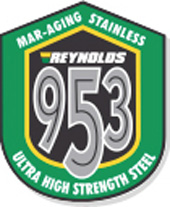Steel has come a long way baby.
The newer Columbus tubes have Nobium in which apart from being a tough metal also allows you to get the tubes hoter when building even welding with out heat damage. Tube are much more corrosion resitant with Chrome and Vanadium in even stainless tubes now. Even the the brazing rods and welding rods are better. You used to use generic brass alloy rods but a SIF 101 rod will give you much improved strenght and a 9% nickle rod will give you a very strong joint. This saves you weight as you can smaller fillets.
But my most loved thing is that you can repair bikes that are beyond saving in most other materieals. I bought a 20 year old roberts and found the whole front end was rotten. Cut it off make a new one braze it on. Job done. You would be a brave man to do that in alloy (even if you own a heat treating oven).
Long live steel! (no actually, long live.... like 50 years if you look after it!)
The newer Columbus tubes have Nobium in which apart from being a tough metal also allows you to get the tubes hoter when building even welding with out heat damage. Tube are much more corrosion resitant with Chrome and Vanadium in even stainless tubes now. Even the the brazing rods and welding rods are better. You used to use generic brass alloy rods but a SIF 101 rod will give you much improved strenght and a 9% nickle rod will give you a very strong joint. This saves you weight as you can smaller fillets.
But my most loved thing is that you can repair bikes that are beyond saving in most other materieals. I bought a 20 year old roberts and found the whole front end was rotten. Cut it off make a new one braze it on. Job done. You would be a brave man to do that in alloy (even if you own a heat treating oven).
Long live steel! (no actually, long live.... like 50 years if you look after it!)
